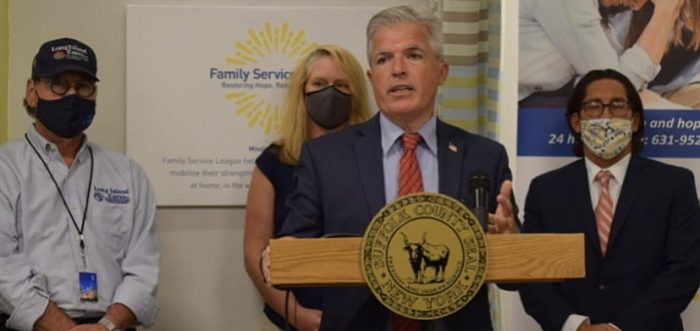The Riverhead Holiday Light Show, 149 Edwards Ave., Calverton kicks off this week on Nov. 19 from 5 to 9 p.m. and continues on Nov. 20 and 21 from 5 to 10 p.m., and Nov. 22 from 5 to 9 p.m. Runs through Dec. 30. The largest drive-through light show in Suffolk County features dozens of dazzling displays to delight the entire family! Tickets can be purchased online at www.riverheadlightshow.com for $23 or $25 at the gate.
Bellone Urges Caution on Thanksgiving Eve
On the night before Thanksgiving, high school and college students typically come together to reconnect, share stories and share a drink.
This year, as COVID-19 cases climb throughout the U.S., including in Suffolk County, County Executive Steve Bellone (D), along with the Suffolk County Police Department and local enforcement offices, are discouraging gatherings that might cause further spread of the virus.
Enforcement efforts will using social host laws, which fine residents for allowing underage drinking, and state-mandated gathering restrictions, which combined, could lead to “serious consequences,” Bellone said on a conference call with reporters Nov. 17.
“No matter where you are or what you are doing, social distancing and mask guidelines must be followed,” Bellone said. “We’ve come too far to go back now.”
With new state restrictions that limit the sale of alcohol after 10 p.m. through bars and restaurants, Bellone said enforcement efforts would be on the look out for gatherings at private residences. Some of these viral spreading events have occurred during smaller gatherings.
“The spread of COVID-19 at these types of parties is very, very real,” Bellone said. “We’ve seen it countless times. We all need to take personal responsibility,” which includes parents who need to comply with social host laws and the state’s gathering limits in homes.
Bellone announced a partnership between the Suffolk County Department of Health and the nonprofit Partners in Prevention, which is starting a social media campaign to inform the community about social host laws. Bellone called this information “critical” leading up to Thanksgiving celebrations.
While Suffolk County enforcement efforts will respond to calls about larger group gatherings, Bellone said police would use “common sense” and would not be “going door to door to check on the number of individuals in a house.”
As for the infection rates, the numbers continue to rise, returning to levels not seen in months.
“We expect our numbers [of positive tests] to be around 400 today,” Bellone said. The positivity rate is about 3.4 percent, while the number of people hospitalized with symptoms related to the virus approaching 100.
“We have not been above 100 since June 18,” Bellone said. In the last 24 hours, the number of people who have required hospitalization from the virus increased by 16.
While the virus has exhausted people physically and mentally, the county cannot “jeopardize our continued economic recovery” and the health of the population by stepping back from measures such as social distancing, mask wearing and hand washing that proved so effective in reducing the spread earlier this year, Bellone said.
“Now is the time to double down on common sense measures that work,” he added.
Some of the positive tests are coming from people in nursing homes, who are among the most vulnerable population.
“With the nursing homes, that is obviously a big concern,” Bellone said. The county is “making sure they have the PPE [personal protective equipment] they need.”
The Department of Health is staying in close contact with these facilities as cases continue to climb.
Bellone urged residents who dined at a Friendly’s restaurant in Riverhead on Nov. 5 or 6 to monitor their symptoms for the next two weeks. Six adults who worked at the restaurant have tested positive for the virus.
Anyone who is exhibiting symptoms of the virus, which include fever, a runny nose, lost of taste or smell, fatigue, shortness of breath, can find a testing site at suffolkcountyny.gov/covid19.
Separately, when asked about the possibility of schools closing in response to the increasing incidence of positive tests, Bellone urged schools to remain open at this testing level.
Stony Brook Offers COVID-19 Testing for Thanksgiving Break
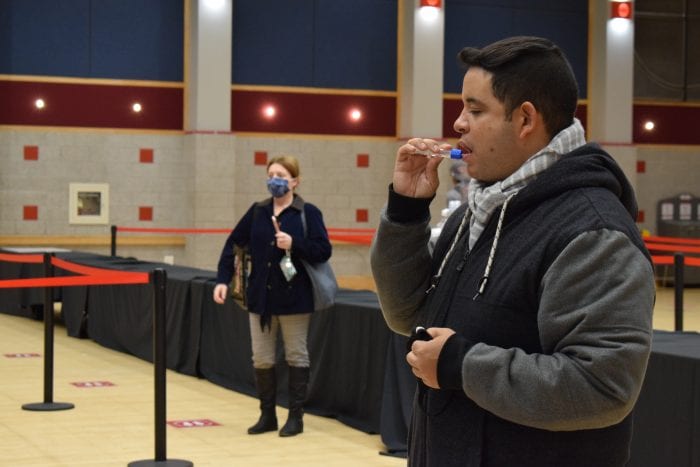
Stony Brook students and faculty have been utilizing the campus’ quick, free saliva swab testing to stay clear of the Coronavirus before holiday break.
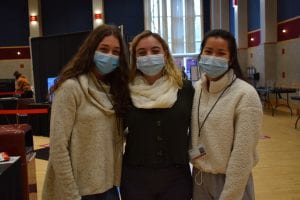
Although students will not be returning to campus after the Thanksgiving holiday, the university began implementing swab testing sites on three parts of campus for commuter students, residents and faculty.
Earlier this month, Marisa Bisiani, assistant vice president for student health, wellness, and prevention services issued a message to students concerning COVID testing and the Thanksgiving holiday.
“We are committed to maintaining the health and safety of our campus community,” she said. “This includes requiring COVID testing for students who, like you, live off-campus, but may come to campus for an in-person class, work on campus or visit campus facilities.”
In accordance with SUNY policy, all commuter students must complete a COVID test within the 10-day period prior to the start of the break.
“As many COVID cases are asymptomatic, meaning you can be infected, and unknowingly and unintentionally spread the disease to others, we want you to know your health status before Thanksgiving to help keep you and your family safe,” she added.
Faculty and students who are on campus from Nov. 9 through Nov. 20 must get tested. If a student will not be on campus at that time, they must fill out an exemption form online.
After scheduling an appointment online, students are able to visit the Student Activity Center, the Health Sciences Center Galleria and for East End students, at the Stony Brook Southampton campus’ student center. There they receive a mouth swab and safely hand it over to the workers for testing. Results come back two to five days after the swab.
“We get over 150 tests done a day,” said Elah Ginsberg, a sophomore on campus who works at the testing site. “Yesterday we have 300 come by.”
The need for quick testing on campus began early last month, with new requirements that faculty, staff and commuter students to get checked for the virus.
“All commuters have to get their cheeks swabbed,” Emily Lam, a senior volunteer at the site, said. “I think it’s way safer and ensures that they’re healthy when they come to campus.”
Patricia Indelicato, health administration coordinator on campus, said she loves that this opportunity is so easily available. “It’s great and it’s helping to keep the community safe.”
Lauren Crennan, who works at the university’s undergraduate college, said that although it’s required for her to get tested, she doesn’t mind doing it one bit.
“I’m happy that they’re doing it,” she said. “It gives me a peace of mind and it’s an easy two-minute walk from my office.”
With New Health Rules, Some Pediatric Illnesses Decline
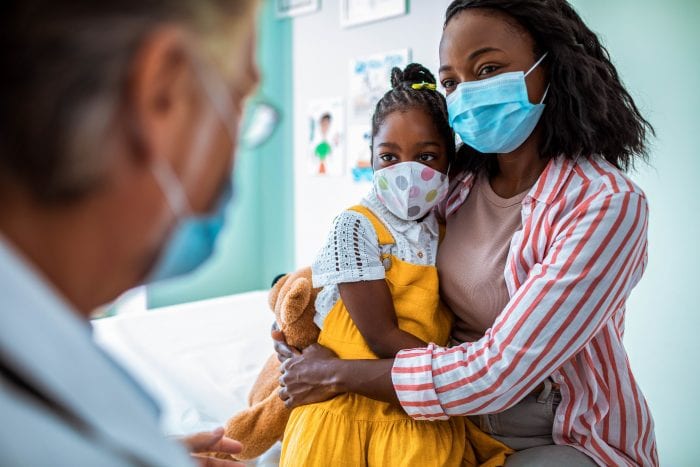
The school and day care mixing bowl of bacterial and viral illnesses has changed. As schools, day-care centers, clubs, sports teams and other organizations change the way they manage group gatherings amid the pandemic, the game of illness tag children seem to play has slowed.
“We are seeing potentially less viral illnesses thus far in the sense that we have not seen an increase yet in respiratory syncytial virus, or RSV,” said Christy Beneri, Associate Professor of Pediatrics and Program Director of Pediatric Infectious Diseases at Stony Brook Children’s Hospital. “We are still waiting to see what happens with the flu.”
The chance of children contracting some of those illnesses would likely be less this year amid the infection control measures to reduce the spread of COVID-19, the disease responsible for the pandemic.
Beneri said children are getting somewhat fewer infections, although doctors are still seeing strep throat, ear infections and pneumonia.
Viral-induced asthma visits have declined at Stony Brook. Children who have asthma are still seeking medical attention, particularly if their condition doesn’t have a viral trigger.
At the same time, the effects of social isolation, uncertainty about the future, and household anxiety has triggered an additional mental health burden, particularly for adolescents.
Pediatricians are “asking patients more about those issues,” she said. “We maybe didn’t ask as much as we should have in the past.”
Even though children generally have less contact with their contemporaries this year, they are still developing illnesses, as their immune system receives challenges from microbes through dirt, pet saliva and other sources.
The dynamic is “slightly different in terms of getting some of these viruses from other people, [but] there are still pathogens in their environment,” she said.
In the current environment, with positive tests for COVID-19 setting new national daily records, Beneri said it is important to practice infection control measures in certain settings, which will impact what children are exposed to over time.
The cultural shift from sending children who might have mild symptoms to school to keeping children home for the good of their fellow students and staff has helped reduce the spread of COVID and other potential infections.
“We’ve taken a step back from what makes sense not just for my child, but for others my child might be exposing,” Beneri said. The decision about whether to send a child who might be battling an illness, cold or minor discomfort to school “is not just about us. It’s about those in our communities and, hopefully, there’s a better recognition” about the impact an infected child can have.
Some of the infection control measures, such as hand hygiene and staying home when children are sick should continue even after companies start providing a COVID-19 vaccine.
At this point, with the virus still prevalent in the community and country, she said acute care visits are declining, as parents are managing at home and are watching and waiting to see how their children recover from any infection.
As a parent, Beneri is dealing with the disappointment and disruption of life in the pandemic for her seven-year-old daughter. Twice, the family has had to cancel a trip to Disney World and has scheduled it for a third time.
Once the worst of the pandemic passes and children get back together again, the pediatric program director said there might be an increase in certain infections, but that doesn’t necessarily mean the county will see horrific outbreaks.
With the approach of Thanksgiving and the December holidays, Beneri urges families to be creative about gatherings. She suggested that smaller groups might want to get together over two weekends, rather than all gathering at the same time.
As for advice to schools, Beneri urges people to remain mindful of their activities outside of school.
“It’d be a shame to have to close schools,” Beneri said.
Beneri added people can celebrate milestones like turning 16, but they should not have a 40-person event in the current environment.
Video of SWR Teens Using Racist Slurs Goes Viral, Superintendent Denounces “Reprehensible” Student Actions
A video of two Shoreham-Wading River students using racial slurs and making racially derogatory comments on social media has led to significant backlash online and from district leaders.
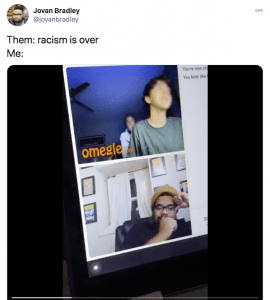
The video in question was on a platform called Omegle, which pairs random people for video chat. That interaction was then published to other social media apps TikTok and Twitter Nov. 10.
The video shows two unidentified young men, who have been named students in the Shoreham-Wading River school district, paired on the social media platform with a man named Jovan Bradley, who according to his Twitter profile lives in Poughkeepsie. Bradley started off the conversation with a greeting, then the young men started with “My N*****” and “What’s up, N****.” The video continues with one of the two young men calling Bradley “slave” and saying, “I’m going to whip you” and mimicking cracking a whip.
Bradley, who is mixed race, later posted a video of the interaction to Twitter and TikTok. In it, he repeatedly asked the young men, “Why?” The Twitter video has been viewed over 38,000 times. The TikTok video has been seen over 417,000 times as of Nov.16.
The names of the two young men have not been released or could not be independently confirmed by press time. People on social media went on trying to find the names of the two students, but some supposed names of the two young men involved have been mistaken for other social media profiles.
Superintendent of Schools Gerard Poole released a statement Nov. 12 saying the video was “reprehensible” and that it was “in clear violation of the core values of our school district.” Poole said the matter will be addressed with both students for further disciplinary action.
The superintendent added that the district is rooted in teachings of “tolerance, acceptance and the importance of embracing diversity,” and they have tried to “cultivate a sense of unity and inclusion in our school community.”
Like many North Shore school districts, Shoreham-Wading River is predominantly white. The district is 87% white, 1% Black, 8% Hispanic or Latino and 2% Asian, according to New York State Education Department data. Long Island has a long history of de facto segregation, and advocates most commonly express this discrepancy by comparing districts like those on the North Shore with places like Brentwood, which is predominately Black and Latino.
Bradley posted to Twitter that at least one parent had contacted him with an apology by one of the students. The other student has yet to send an apology, according to the Poughkeepsie man’s latest TikTok post. Bradley has posted that he has gone on Omegle to debate people and also publicly shared his response to the apology Nov. 13, saying he hopes the young man takes “positive things from this experience” and that he hopes the young man sees fault with his actions “at a human level.”
“Take this experience to continue to educate yourself on what has and is happening in our country,” Bradley said in his post. “I do wish you a bright future if you can make those changes. Everyone deserves a second chance.”
Nonprofits Offer More Help for Youth Mental Health
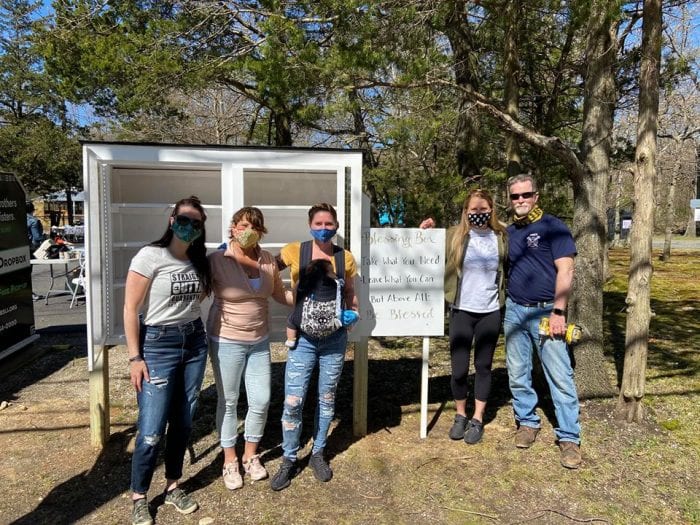
It’s been a stressful time.
In the age of COVID-19, more and more organizations are attempting to adapt to the influx of people needing mental health.
Last month, Steve Chassman, executive director of the Long Island Council on Alcoholism and Drug Dependence, said in a press conference in September regarding potential Suffolk healthcare cuts that substance abuse has skyrocketed because of the coronavirus crisis. “We have propelled to where we were six months ago,” he said at the time.
And that’s why the Sunshine Prevention Center in Port Jefferson Station is here to help. Carol Carter, CEO/co-founder of the community youth and family agency that offers support and education in the areas of drug/alcohol prevention, socials skills, leadership and alternative education, said in the age of COVID, they had to adapt to help more people.
“When COVID-19 first hit, we really scrambled,” she said. “We worked really hard to build a reputation in the community for still providing services.”
The center quickly learned how to Zoom and create Facebook Live and YouTube videos for kids and families to watch at home.
“We had close to a thousand people watching them,” she said.
According to Carter, the group learned that the rate of anxiety and depression was getting higher at the start of the pandemic, and domestic violence increased to at least by 20%. She and her organization knew how important it was to help people during such a trying time.
“We would drop off [worksheets/exercises] to homes,” she said. “We tried not get so caught up in the fear, but we wanted to be there to help them.”
As the pandemic evolved, so did their online learning. Carter began writing daily, weekly and then monthly newsletters. “They would have resources and positive messages for the day,” she said. “We’d mention other programs that were running. … We tried to stay connected that way.”
The center began to Zoom meetings for kids, young adults and parents at night, but more recently in September, they began socially distanced in-person adult groups again.
“We started in-person because of the demand,” she said. “They need more of the social interaction. … We’ve been told ‘thank you.’ We tried to get back to some type of normalcy. Although people are still afraid, they’re grateful.”
But along with the substance abuse problem as described by Chassman, everyone is feeling more anxious than before.
Further east at the North Shore Youth Council in Rocky Point, Dana Ellis, director of mental health and wellness programming, said she has seen a dramatic increase in anxiety among young adults.
“Anxiety is the biggest thing I’m seeing more so compared to last year,” she said. “The amount of kids and interests approaching doubled. … A lot more people are looking for help and support during this time.”
Before COVID-19, her group would work with Rocky Point school district to help students with their mentoring program. This year, however, they were unable to meet because clubs were canceled.
“My biggest thing is giving kids opportunities to socialize, meet people, talk with each other and recognize things will be OK,” she said. “Our goal is to increase mental health programing in general.”
The youth council also decided recently to restart in-person group meetings, because they know how important it is for young adults to talk about how they’re feeling. Upon arrival, they give temperature checks, must wear masks and have the option to Zoom in, if they choose.
“I’ve definitely started off my groups with coping skills,” Ellis said. “I started treating them like stressless groups because more than ever kids are stressed, and I’m trying to make that the forefront of the groups that I run.”
In those groups, people talk about the worries they face in day-to-day life. ““I think that’s from a variety of things,” she said. “In general, it’s a very stressful time we’re living in.”
Fire Officials Thank Covanta for Big PPE Donation at Pandemic’s Start

Local Electeds joined fire department members to celebrate a North Shore power plant for donating PPE during the height of the pandemic.
Suffolk County Legislator Sarah Anker (D-Mount Sinai) recently joined Riverhead Town Supervisor Yvette Aguiar, Brookhaven town Councilwoman Jane Bonner (R-Rocky Point) and local fire department members at the Wading River Fire Department to thank and honor Ken Hinsch and Convanta Energy of Huntington for their donation of personal protective equipment to the Wading River, Ridge and Rocky Point Fire Departments during the start of the COVID-19 pandemic. Covanta Energy of Huntington’s donation included over 15 cases of Tyvek suits and N95 masks that were distributed to Wading River, Ridge and Rocky Point Fire Departments. The donation was estimated to be between $5,000- $6,000 in supplies.
“This pandemic has brought many challenges to our community, including the availability of much needed PPE for our emergency responders,” Anker said. “I am so thankful to Covanta and their Facility Manager, Ken Hinsch, for donating PPE to our local fire departments, and to our fire department
volunteers who have continued to protect and provide emergency services to our community members throughout the pandemic.”
Covanta is a waste management company that regularly uses PPE. In April, Wading River Fire Commissioner Kevin McQueeny reached out to Covanta’s Facility Manager, Ken Hinsch, when the department was nearly out of the life-saving equipment. Ken Hinsch coordinated with the Wading River, Ridge and Rocky Point Fire Departments, donating several cases of Tyvek suits and N95 masks. A member of the Ridge Fire Department drove to the Huntington location to receive the initial donation, while the remaining donation was given to the Wading River Fire Department. The Wading River Fire Department then distributed a portion of the donation to the Rocky Point Fire Department.
“The Board of Fire Commissioners, the Chief’s office and the volunteers of the Wading River Fire Department would like to thank Covanta Energy of Huntington and their Facility Manager, Ken Hinsch, for the generous donation of much needed PPE during the COVID-19 pandemic,” said Wading River Fire Commissioner Kevin McQueeney.
Bellone: County Entering ‘Dangerous Period’ for Virus, Urges People Avoid Gatherings
Just as many areas in the rest of the country are experiencing a rise in positive tests for the coroanvirus, Suffolk County has now completed a week in which the numbers have climbed quickly.
The seven-day moving average of new cases is over 300, compared with an average of 119 the prior week.
“For a full week, we’ve seen an alarming spike in new COVID-19 cases,” County Executive Steve Bellone (D) said on a conference call with reporters.
Gov. Andrew Cuomo (D) has issued new guidelines starting this evening for restaurants, bars and fitness centers. Starting at 10 pm, each of those businesses is required to close from 10 p.m. to 5 a.m. Restaurants are allowed to offer curbside dining for pick up only after 10 p.m., but they can’t serve alcohol after that time.
At the same time, gatherings are limited to 10 people, in part because smaller collections of people have contributed to the rise in positive tests.
Starting today, the county will also deploy six teams, consisting of one fire marshal and one staff member from consumer affairs to boost ongoing compliance.
These teams will speak with businesses about new restrictions. The first focus will be on gaining compliance and informing and educating the public. These new teams will have the authority to issue citations if they “detect or observe egregious violations,” Bellone said.
These new restrictions are the first in the county since the spring.
“We don’t want to see new restrictions take effect that will slow the recovery more,” Bellone said. “That will all be dependent on what we do in the next couple of weeks.”
The county has a “short window” in which to get these numbers under control, the county executive continued.
The county has activated 200 additional case investigators and has 1,000 contact traces following up on positive tests within the county.
The goal is to get index cases as quickly as possible within a 24-hour period, Bellone added, to reduce the spread of the virus.
Bellone urged people to avoid gatherings this weekend to the greatest extent possible.
“We are entering a dangerous period for this virus,” Bellone said. “We have long talked about the possibility of a second wave in the fall. It very much feels like that’s where we are.”
With two weeks left until Thanksgiving, Bellone reminded residents that the time to quarantine is limited.
People need to follow best practices, which includes social distancing, mask wearing and hand sanitizing, even as the weather gets colder and residents spend more time indoors.
Election Stress: Psychological Strain of Recent Election Hits Home
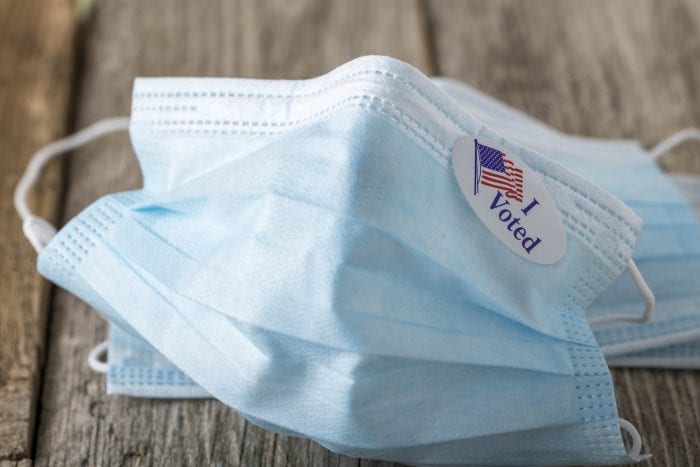
Though this year’s election arguably lasted far longer than any other in recent history, the way even the presidential election has lingered in the news has not slowed the amount of stress people are feeling in its wake.
A study conducted by market research firm The Harris Poll for the American Psychological Association, released Oct. 7, said 76% of Democrats, 67% of Republicans and 64% of Independent voters said the election was a major stressor in their lives.
“Many people are isolated, and in such a politically charged environment, there’s just a lot of uncertainty about the future.”
— Dr. Donna Friedman
Local psychologists have witnessed the general anxiety from their patients and the 2020 election’s impact on mental health. Dr. Donna Friedman said among her clients who go to her in her East Setauket practice, she would agree with the APA’s study. And with the combination of the COVID-19 pandemic and protests all around the country over law enforcement, the level of election stress is something she has never before seen in her near 35 years in private practice. Worse, lingering questions of a peaceful transfer of power and absentee ballot counts have made this period of heightened tension last.
Though people may not have the same political viewpoints, many of them share similar feelings of stress. Every person is different, and among the many issues of an issue-filled age, individuals have a much bigger opportunity to feel anxious. The APA study points out those with chronic health conditions are significantly more likely to say the election is a very significant source of stress for them.
“For some people the issue is Trump and how he treats women, for another person it might be issues with police, how law enforcement has affected them — it depends,” Friedman said. “It’s not across the board everyone feels the same way.”
What people are feeling stressed and anxious about also depends on different demographics. For people of color, the election was even more of a stressor than previous years, such as with Black people at 71% in 2020 compared to just 46% in 2016, according to the APA study.
Dr. Chris Kearney, a fellow East Setauket-based psychologist, said with all the external factors, this current election has heightened stress further than he’s seen before from any other election.
Kearney, who works with both adolescents and adults, said young people are afraid of what this pandemic and election mean for them right now, whether it will impact their ability to go to college or get a job. Adults are more stuck on where they are, he said, and it’s more difficult for them to open up.
“For the teens, it’s what’s going to happen in the immediate right now, for the adults they’re very unrelenting — once they have an opinion, it’s hard to interject another rationale,” he said.
As a therapist, his role is to stay neutral even when his patients talk about their personal political views, though he said for adults it’s important to know such animosity to the other side can become imprinted on younger children.
Friedman said people being cut off from their social contacts because of the ongoing pandemic has only helped exacerbate the issue, and this stress is much more apparent with older than younger folks. Older people are more afraid of getting sick, or even being alone and getting sick. Younger people speak less about fear of getting sick, but more so how they will be impacted by the election.
“I think that volatility just continues in our everyday life and behaviors, and that’s why that stress level is increased.”
— Dr. Chris Kearney
“Many people are isolated, and in such a politically charged environment, there’s just a lot of uncertainty about the future,” she said. “People are divided from each other when they really do need to feel connected.”
With more people seeking or coming back to therapy, local psychologists said this charged political time has truly damaged relationships among both family and friends. The APA has suggested people need to break habits of ruminating on the worst-case scenario and instead focus on things one can control and engage in meaningful activities.
Friedman said people need to practice good self-care. Part of that includes limiting time one might spend hooked into the 24-hour news cycle. News can become “addicting,” she said, and it might be best to limit oneself to specific points in the day where you can read or watch to catch oneself up. She added people need to focus on maintaining social connections as best as one can, and should also try to distract oneself from the surrounding negativity through hobbies or other interests, anything from gardening to taking walks.
Kearney said it’s important to not let a difference of opinion between you, your family, friends or even coworkers become volatile.
“I think that volatility just continues in our everyday life and behaviors, and that’s why that stress level is increased and gets even higher,” he said. “If we work together and help each other, we can maybe reduce that volatility in our relationships.”
SBU International Students Voice Concerns Post-Election
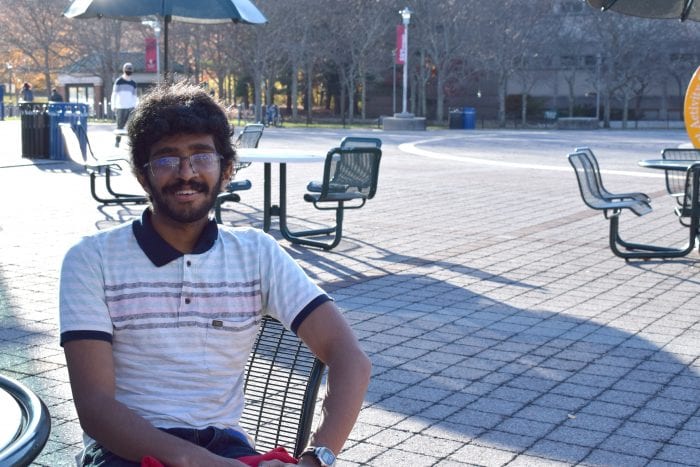
Kaung Kyaw arrived in America when he was 19. “I’ve always thought since I came here that I’m a foreigner, so my opinions really don’t matter,” he said.
He is just one of more than 4,000 international students who come to study at Stony Brook University from 103 countries. They make up a large, diverse population either living on campus or nearby. Many credit this international community for driving the large numbers of ethnically varied offerings of both shops and restaurants in the Setauket/Stony Brook area. Their inclusion in the community has led to events like the annual Dragon Boat Race Festival in Port Jefferson and the Chinese New Year celebration by the Ward Melville Heritage Organization.
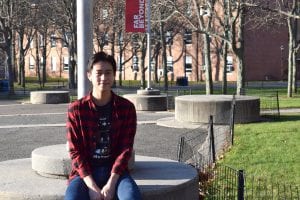
Kyaw, a 21-year-old student from Myanmar, came to the U.S. in 2018. He said he always had dreamt of coming to the United States and decided to choose SBU as his place of study to become a surgeon.
But before he traveled here, he remembers hearing that Donald Trump was elected as Republican president back in 2016. Kyaw’s initial thought was, “What were they thinking?”
“I thought it was so funny,” he said. “But now I’m living this reality and it’s not funny anymore.”
Kyaw is currently studying biology. After graduation, he said he would like to hopefully continue his education in the States. That, however, has been complicated by the president’s addition of his home country to a list of nations on a travel ban in January this year.
“If I get to stay here, I would practice here,” he said. “But right now, that’s not possible because of Donald Trump’s travel ban.”
He said that because of the current presidency, his view of America has morphed into a vision that isn’t always that welcoming.
“When he tried to send us all back a few months ago, that was really cruel and was really unfair,” he said. “We pay a lot of money to be here and study here. We don’t deserve this kind of treatment — nobody does.”
During the COVID-19 crisis, Kyaw said he was subjected to racism. He never imagined this when he considered coming here.
“I thought America would be this amazing place with lots of job opportunities,” he said. “I didn’t think of the racism or any other bad issues here. America was just this dream place to be in. But I got here, and these are topics we cannot escape — I didn’t know how much it’s ingrained into everyone’s minds.”
Minal Chawla, 19 from India, said she was just 17 when she decided to study abroad at Stony Brook. “Before coming to the U.S., I think I never paid much attention to what was happening in American politics and what was going here in general,” she said. “But now I try to keep myself up to date with all the latest happenings because I think in one way or the other, they affect me.”
Chawla, who is studying health sciences and journalism, said that there is so much happening in the U.S. that her future appears a little more unclear because of the uncertainties.
“I have a whole plan of what I want to do after graduation,” she said. “But now looking at the current scenario, I am unsure about whether I will be able to achieve it or not because the immigration policies can change at any moment and things can go south all of a sudden.”
She added that under President-elect Joe Biden’s new Democratic administration, she’s hopeful. “I hope that the decisions they take are in favor of all the international students who plan to work or settle in the U.S. after studies,” she said. “Currently, I am just trying to focus on the bright side and practicing gratitude by reflecting upon the things that I am thankful for.”
Veronica Alvarenga Hon, 21 from Costa Rica, has spent two-and-a-half years in the States. She said that before coming here, she always found the American electoral system to be interesting. In Costa Rica, they elect the president according to popular vote.
“I do have to say that for a long time, the U.S. portrayed itself as the leader of the free world — they were an example of what you could achieve by valuing freedom and respecting other people’s rights,” she said. “This, for some reason, made the U.S. seem more liberal in my mind. I was very surprised that many people were very conservative, even by my own standards.”
The 2020 election, to Hon, was polarizing. “President Trump often uses inflammatory rhetoric which only riles people up more,” she said. “I think this is just another example of the populist trend that we are seeing in the world. It was very disappointing to see so many people voting for the opposite of what I would consider American values, such as equality, freedom, respect and tolerance.”
“This, for some reason, made the U.S. seem more liberal in my mind. I was very surprised that many people were very conservative, even by my own standards.”
— Veronica Alvarenga
But she said it’s natural for people to disagree when it comes to politics. “I just don’t think it’s usually so personal to everyone,” she said.
Hon added that she viewed the election more about getting Trump out of office, rather than liking Biden.
“The U.S., once the leader of the free world, seems to have forgotten that to lead, you need people that will follow,” she said. “I am hoping that the Biden administration takes a different approach in their foreign policy — one that would consider rejoining the Paris Agreement, the World Health Organization and the JCPOA [known commonly as the Iran nuclear deal].”
Kyaw agreed. ”Trump being the president has shown you how much racism there is in America,” he said. “This was all there before he came in the spotlight. They just started expressing it and people started becoming nastier and nastier. We need to start fixing that.”
Abhishek Cherath, 21 from Mumbai [formerly Bombay] in India said in his opinion bringing back America to what it was before Trump’s presidency will not be easy.
“The things that are being put at risk by Trumpism are much longer lasting than anything else,” he said. “Politics is dirty. But the only alternative to politics is war — that’s not a good alternative.”
Under a Biden term in office, Cherath said he hopes things will be more pleasant among his American colleagues.
“I don’t really know what I’m going to do, but I hope America is OK,” he said. “Because there’s a lot of wonderful stuff that happens here, and it will be a real shame to just have that all vanish into a civil war.”





